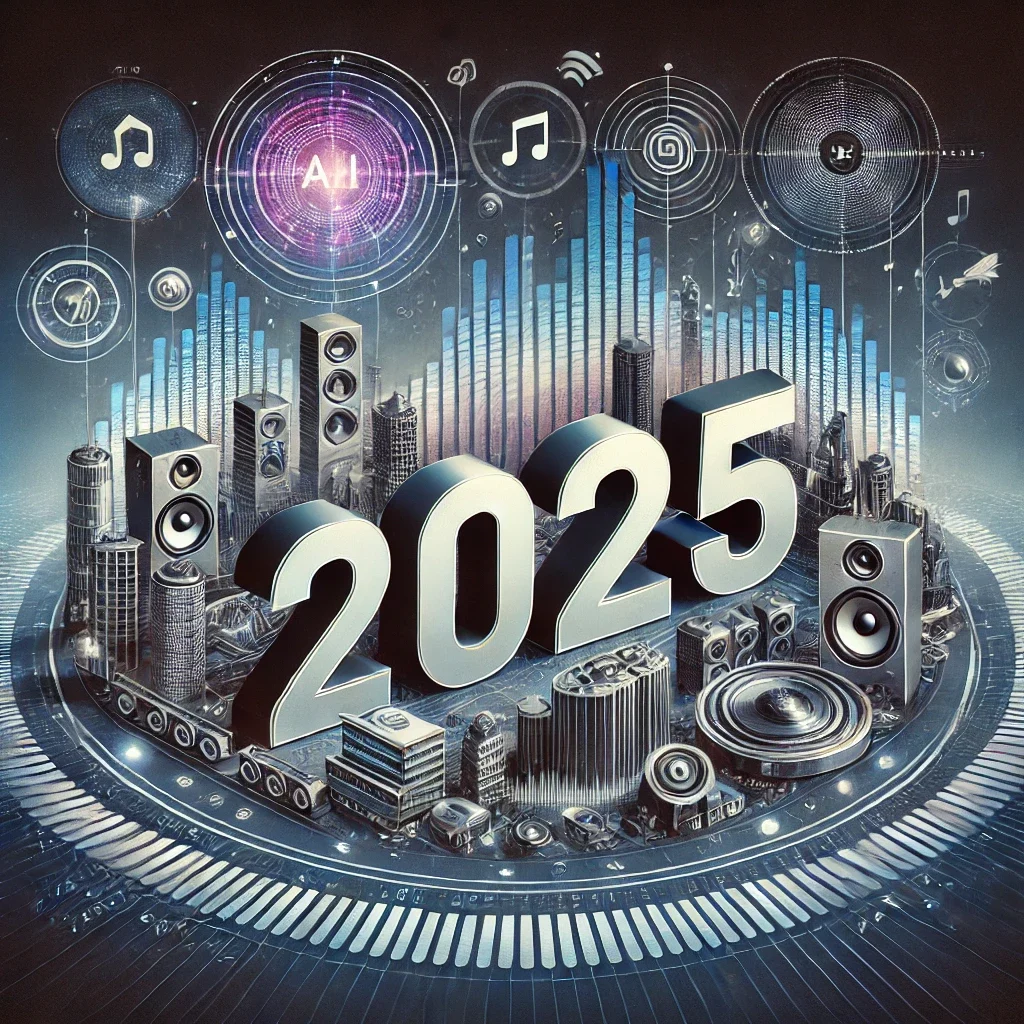January 6, 2025
In this article, we’ve explored some of the music trends, technologies, and cutting-edge ideas that could define the music of 2025.

AI music revolutionizes the industry
AI is here and making its mark on the music industry. In 2025, artificial intelligence won’t just be a tool for writing copy or streamlining workflows; it will be a creative collaborator that musicians and producers can use to create more innovative tracks.
So, why is AI music trending? As technology advances, AI has become more sophisticated, able to analyze massive amounts of data to create music that sounds eerily human. Spotify’s new AI DJ is already curating playlists that feel personalized, while artists like Grimes and Holly Herndon are using AI to push the boundaries of music using a technique called “spawning.”
AI will play an even more significant role in music production in the coming year, from generating beats to crafting entire compositions. While some purists might scoff, there’s no denying that AI is opening up new possibilities for creativity—the future of music is here!
Live music will be more valued than ever
Live music is going through hard times. Rising costs are making it tougher than ever for bands and artists to earn money from performing. Music venues in countries like the US and UK are shutting down at a rapid pace. And music fans are spending less money on luxuries like concerts, while ticket prices are spiraling. Meanwhile, streaming platforms and other digital media promise to bring us all the entertainment we need in the comfort of our homes.
In spite of these disheartening music industry trends, people still value live music. A recent Spotify report found that 74% of young people have attended a live concert or show in the last year. Taylor Swift’s Eras Tour was one of the most significant cultural events of 2024, having a major economic impact on the cities it touched down in. On a smaller scale, music fans have embraced new forms of live music experience, such as album listening parties.
All of this shows that, regardless of their economic situation, music fans still crave the special energy of a live event. In 2025, live shows will continue to be crucial to the future of music – even as the financial margins become ever tighter. Musicians who can craft special, meaningful live experiences on a tight budget will be rewarded by their fans.
TikTok songs takeover
Nowadays, TikTok is the go-to platform for discovering new artists and fast-tracking the hottest tracks, with viral hits launching careers and dominating the charts faster than you can say “For You Page.”
But what makes TikTok songs so popular? It’s all about the bite-sized, catchy clips users can’t get enough of. Whether it’s a beat drop accompanying a dance challenge or an acapella hook that gets stuck in your head, TikTok can turn obscure sounds into mainstream anthems—and some are actually making it to the charts!
In the coming year, we’ll see even more artists create music specifically with TikTok in mind. The platform’s influence is only growing, with comedy creators like Millie Ford even dropping tracks getting radio play after going viral. Even pop star Zara Larsson has also recently seen the benefits of a viral (and pretty unhinged) trend featuring one of her older songs, giving her a massive boost in awareness and revenue. She even embedded the trend into her live performances! It’s TikTok’s world—we’re just living in it!
Increased focus on ADHD music
Need to increase your focus? There’s a playlist for that. ADHD music—tracks specifically designed to help you concentrate—is a genre that’s growing in demand. Whether studying, working, or just trying to stay on task, these beats help you stay in the zone.
So, why is ADHD music on the rise? As more people juggle remote work, online learning, and the constant distractions of daily life, there’s a growing demand for music to boost productivity. These tracks are typically instrumental, with rhythms and tempos scientifically designed to keep your brain engaged without being intrusive. It’s all about finding that sweet spot where the music helps you focus without drawing too much attention to itself.
Expect this trend to grow as more artists and producers experiment with creating ADHD-friendly music.
3D music & spatial audio
Why is this trend taking off? As listeners crave more immersive experiences, 3D music, and spatial audio offer something traditional stereo tracks can’t match. The music isn’t just playing—it’s happening all around you.
Artists like Billie Eilish are already exploring this new frontier with tracks that seem to wrap around you, creating an immersive experience that only heightens the emotion—even Sony’s new WF-C510 Earbuds feature “Ambient Mode,” including 360-reality audio.
Expect more artists and producers to embrace 3D sound mapping and spatial audio, transforming their songs into an immersive sonic adventure. Whether it’s a live concert experience or a studio track, this trend is set to redefine how we listen to music in 2025 and beyond.
Consider the trends
These are predictions, however, as we have seen in previous years the music industry can be highly transformative and dynamic. These trends can be used as considerations for CMOs who are reviewing their current systems and processes.
The continued rise in screaming has left Artists losing out on millions of unclaimed royalties due to errors in metadata . Music matching technology can help music rights organisations address this issue and ensure accuracy.
The Matching Engine uses configurable parameters to automate, identify and match data.. A foundation of Azure and Databricks technology provides the ability to process and transform data from various streaming platforms and in different formats at scale.
Talk to Spanish Point Technologies about our music Matching Engine helps prepare your systems for the future.
Source: https://elements.envato.com/